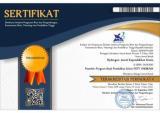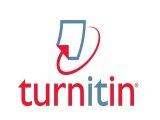Karakterisasi Karbon Baggase Teraktivasi dan Aplikasinya untuk Adsorpsi Logam Tembaga
Abstract
Bagasse is waste produced from the process of milking or extracting sugarcane stems. Baggase can be optimized in terms of use value and its function as an alternative technology, namely as an active carbon manufacturing material that can be used as a copper (Cu) adsorbent. This study discusses the functional baggase activated carbon group of phosphoric acid and nitric acid using Fourier Transform Infra Red (FTIR) and its application as a copper metal adsorbent in silver craft waste in Ungga Village, Praya, Central Lombok. The production of activated bagasse carbon consists of three stages, namely first dehydration by burning bagasse until it turns into carbon, the second carbonation is heating at 500ºC, carbon results are 100-200 mesh and third, activation by soaking 50 grams of carbon in 500 mL of 20% phosphoric acid and 20% nitric acid for 12 hours. After that the carbon is dried at 110ºC and finally heated at 500ºC for 1 hour. The bagasse carbon that has been made is put into 25 mL of waste water sample with a mass of 2 grams of adsorbent. Samples were then stirred at 30, 60, 90, 120 and 150 minutes contact time variations at a speed of 180 rpm using a batch system. The optimum contact time that is used to calculate the efficiency of copper metal content reduction is by calculating the difference in the metal content of copper metal before it is adsorbed and after it is adsorbed using activated carbon baggase. Concentrations of all copper metals were analyzed using Atomic Absorption Spectrophotometer (AAS). Identification using FTIR spectrophotometer shows that carbon baggase in this study contains functional groups C = O, C = C, C-C, N = O, C = N, C-OH, CH2 and C-H. From the research it was found that the copper metal content in the sample was 14.5710 ppm. The optimum contact time on copper metal adsorption is at 120 minutes contact time which results in optimum adsorption efficiency on copper metal that is 84.88%. Activated carbon baggase is an effective adsorbent to reduce levels of copper metal in silver craft waste.
Keywords
Full Text:
PDFReferences
Apriliani. 2010. Pemanfaatan Arang dari Ampas Tebu Sebagai Adsorben Ion Logam Cd, Cr,
Cu, dan Pb dalam Air Limbah. Skripsi. Jakarta : Universitas Islam Negeri Syarif
Hidayatullah.
Handoko, C.T., Yanti, T.B., Syadiyah, H., dan Marwati, S. 2013. Penggunaan Metode
Presipitasi Untuk Menurunkan Kadar Cu dalam Limbah Cair Industri Perak di
Kotagede. Jurnal Penelitian Saintek. 18 (2) : 51 -58.
Jaguaribe, E.F., Medeiros, L.L., Barreto, M.C.S.,and Araujo,L.P. 2015. The Performance of
Activated Carbons from Sugarcane Bagasse, Babassu, and Coconut Shells in Removing
residual Chlorine. Brazil.
Kaur S., Walia T.P.S.,and Mahajan R.K. 2008. Comparative Studies of Zink, Cadmium,
Lead, and Copper on Economically Viable Adsorbents. Journal Environ. Eng. Sci. 7 :1 -
Manocha, S. M. 2013. Porous Carbons. Jurnal Sadhana. Vol. 28, part 1 dan 2.
Mohideen, M.Faizal, M.Faiz, H.Salleh, H.Zakaria, R.V. Raghavan. 2011. Drying of Oil Palm
Frond via Swirling Fluidization Technique. Proceedings of the World Congress on
Engineering. Vol. III. ISSN : 2078-0966
Palar, H. 2012. Pencemaran dan Toksikologi Logam Berat. Jakarta : Rineka Cipta.
Purnawan, C., Tri M., dan Shofiatul A. 2014. Penurunan Kadar Protein Limbah Cair Tahu
dengan Pemanfaatan Karbon Bagasse Teraktivasi. Jurnal Manusia dan Lingkungan.
(2) : 143-148.
Roto, R., Indah, D.R., dan Kuncaka, A. 2015. Hydrotalsit Zn-Al-EDTA Sebagai Adsorben
Untuk Polutan Ion Pb (II) di Lingkungan. Jurnal Manusia dan Lingkungan. 22 (2) :
-232.
Salman. 2014. Optimization of Preparation Conditions for Activated Carbon from Oil Palm
Frond Using Response Surface Methodology on Removal of Pesticides from Aqeous
Solution. Arabian Journal Chemistry. 7(3): 101 -108.
Selvi, K., Pattabhi S and Kardivelu K. 2011. Removal of Cr(VI) from Aqueous Solution by
Adsorption Onto Activated Carbon. Bioresour Technol. Vol 80 : 87-89.
Shofa. 2012. Pembuatan Karbon Aktif Berbahan Baku Ampas Tebu dengan Aktivasi Kalium
Hidroksida. Skripsi. Jakarta : Fakultas Teknik Kimia Universitas Indonesia.
Sulistyawati, S. 2008. Modifikasi Tongkol Jagung Sebagai Adsorben Logam Berat Pb (II).
Skripsi. Bogor : FMIPA IPB.
Tandy, E., Fahmi, I., and Hamidah. 2012. Kemampuan Adsorben Limbah Lateks Karet Alam
Terhadap Minyak Pelumas dalam Air. Jurnal Teknik Kimia. 1 (2) : 70-75.
Wahjuni, N.S., Danny, A., dan Desty, R. 2015. Perbandingan Tingkat Adsorpsi Chitin dan
Karbon Aktif dalam Menjerap Logam Chromium dalam Tangki Berpengaduk. Seminar
Teknik Kimia Fakultas Teknik UNS, Surakarta. Hal. 71 -76.
DOI: https://doi.org/10.33394/hjkk.v7i2.1912
Refbacks
- There are currently no refbacks.

This work is licensed under a Creative Commons Attribution-ShareAlike 4.0 International License.





